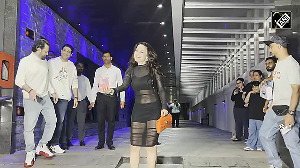Place: New Howrah bridge on the river Hooghly in the city of Kolkata
Time: 11.30 pm on October 29, 2007
Dharmendra Saha, resident of Kolkata, who is driving a pollution-friendly Swift in the traffic jam caused by four long rows of trucks, stretched out his hand out of the window and almost screamed, "Look, you can almost touch the air pollution."
He was referring to the haze on the bridge over the river Hooghly and dust particulates that were blocking the view of the flowing water under the bridge.
While echoing his fears, he told rediff.com, "It's frightening. These trucks are terrible. Not only do they pollute the city, they are affecting the future generation."
The city that epitomises cultural dreams and the aspirations of Indians since decades is witnessing more than 4,000 deaths every year, more in winter due to air pollution caused, mainly, because of the ever-growing army of vehicles.
Saha's concerns have scientific backing too.
"Things are not in right shape. Respirable suspended particulate matter has to be under control," Dr Deepak Chakravarty, chief scientist of the West Bengal Pollution Control Board, sadi giving a grim picture of Kolkata's environmental woes and an idea of things to come to a group of journalists, earlier in the day.
Tiny particles emitted by vehicles, which are on the road without proper pollution control mechanism, when breathed damages the lungs.
The level of these particulates is more than double the standard fixed by the World Health Organisation. Kolkata has the highest number of cases of lung cancer (18.4 people per one lakh residents suffer from lung cancer).
Dr Chakarvarty was standing on the green lawns of the Victoria Memorial Park, that grand reminder of colonial history.
Here the West Bengal Pollution Control Board has erected a small cabin with machines from France analyses the pollution levels in Kolkata round the clock.
The machine, costing Rs 1 crore churns out data important to assess the kind of air people of Kolkata are inhaling. And, the answers are startling and alarming.
He said that data from April 2006 to March 2007, also available on the web site of WBPCB (www.wbpcb.gov.in) show that often the nitrogen dioxide and carbon monoxide levels remain well above national standard. The level of sulfur dioxide is under control.
Dr Chakarvarty said Kolkata has 17 monitoring stations, which include spots around industrial establishments and busy traffic signals where air pollution is expected to be high due to emissions from vehicles. He said that during the night due to diesel vehicles, the pollution level is quite high.
Between October 2006 to March 2007, the RSPM level was quite higher than the national standard. The effects on health of these air pollutants are well known.
Dr Ujjaini Sarkar, resident of Kolkata and reader in the Department of Chemical Engineering, Jadavpur University says, "In winter you feel worse. You feel chalked out because of particulates in air. It is bad metrology that affects us."
In Kolkata, the issue of air pollution is quite complex and will need years to fix.
One, government tried to ban old trucks, buses, auto rickshaws and taxis manufactured before 1991.
But, the high court scrapped the order. The environmentalists alleged that the government didn't prepare a strong legal case.
Two, there are more than 1 lakh such vehicles, which are killer vehicles causing serious lung and cardiovascular-related diseases, but the taxi union's lobby is strong and the union is headed by the ruling party minister who also sits to decide to take action against the smoke belchers.
The local media has alleged that Transport Minister Subhas Chakraborty does not show the political will to tackle the issue of emission by old vehicles. He told a local daily, "Environment cannot be viewed in isolation. It has socio-economic considerations."
According to experts, a higher level of RSPM affects the respiratory system, can cause asthma, bronchitis and other lung diseases and cancer.
Higher level of nitrogen dioxide found in the air can cause lung damage, eye irritation, respiratory problem and can increase secondary infection in children. Carbon Monoxide can reduce the mental alertness and is capable of aggravating cardiac problems.
But, experts find it hard to convince the government and sometimes even people about the dangers of pollution because those who want to dodge the issue say that people are dying "for thousands of reasons."
The devastating affects of air pollution are not only borne by the people of Kolkata.
New Delhi is in no position to boast of clean air, something basic to human lives. On November 6, almost all newspapers in Delhi had covered the haze giving gloomy details.
The Centre for Science and Environment claims this winter Delhi will reel under air pollution unless drastic steps are taken.
This is more alarming because Delhi is that rare city in India where the Supreme Court had intervened and had strictly monitored the steps taken by the government to correct the alarming level of pollution.
In spite of it things are deteriorating.
Since, 2000, New Delhi vehicles have shifted to CNG (Compressed natural gas) to control air pollution.
The CSE claims, seven years after, Delhi is facing another onslaught -- air pollution is back with a vengeance in the city. In fact, it is going back to the pre-2000 levels.
Levels of respirable suspended particulate matter were 244 microgram per cubic metre in November 2000 -- in the same month in 2006, they had already crossed the 250 microgram per cubic metre-mark.
CSE says that it is "a real and present danger -- especially with the 2010 Commonwealth Games breathing down our backs."
If one takes figures of the air pollution monitoring centre in Tughlakabad area from the fourth week of October the story is no different. The RSPM in Delhi, near Batra hospital, was four times higher than the desired level.
According to the CSE Centre, 72 per cent of pollution was due to vehicles.
New Delhi alone is bearing the burden of 2,000 metric tones of pollutants emitted by various sources. The shoking fact is in India the majority of vehicles do not go through proper pollution control tests.
In India, more than 200 monitoring centres are set up by private and government bodies, which analyses the air pollution on a daily basis using technology imported from France.
The problems to tackle pollution may be very complex, thinks Chakravarty.
He claims that a lot is being done to improve the pathetic conditions, but the process is slow. "It takes time to convince people that whatever is happening is not good for us. But in an economically developing country, it will take time," he added.
Coming to the crux of the problem he asked, "Who will bear the cost? We are a poor country. For a better environment, there is the product and travel cost. We will have to convince people if you want good living then pay (for it)."






 © 2025
© 2025